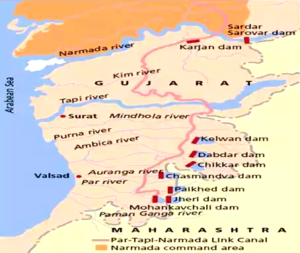In news– The tribals in Gujarat’s Valsad district have been protesting against the Centre’s Par Tapi Narmada river-linking project. The movement is backed by Samast Adivasi Samaj, Adivasi Samanvay Manch, Adivasi Ekta Parishad and other political parties.
About the river-linking project-
- The project was envisioned under the 1980 National Perspective Plan under the former Union Ministry of Irrigation and the Central Water Commission (CWC).
- The project proposes to transfer river water from the surplus regions of the Western Ghats to the deficit regions of Saurashtra and Kutch.
- It proposes to link three rivers:
- Par, originating from Nashik in Maharashtra and flowing through Valsad.
- Tapi is from Saputara that flows through Maharashtra and Surat in Gujarat.
- Narmada originates in Madhya Pradesh and flows through Maharashtra and Bharuch and Narmada districts in Gujarat.
- An MoU was signed between Gujarat, Maharashtra and the Central government on May 3, 2010, that envisaged that Gujarat would get the benefit of the Par Tapi Narmada link project through en-route irrigation from the link canal and in the drought-prone Saurashtra Kutch region by way of substitution.
- The Detailed Project Report (DPR) for the project was prepared by the National Water Development Agency (NWDA) in 2015 and modified on the intervention of the Gujarat government.
- The Gujarat government had, in December 2016, proposed providing a pipeline system instead of open canals to “avoid/minimize the land acquisition in tribal areas” as well as to reduce evaporation and seepage losses.
- The link mainly includes the construction of seven dams (Jheri, Mohankavchali, Paikhed, Chasmandva, Chikkar, Dabdar and Kelwan), three diversion weirs (Paikhed, Chasmandva, and Chikkar dams), two tunnels, the 395-kilometer long canal, and six powerhouses.
- Of these, the Jheri dam falls in Nashik, while the remaining dams are in Valsad and Dang districts of South Gujarat.
- Presently the water of Sardar Sarovar is used in urban areas and for irrigation in Saurashtra.
- Besides providing irrigation benefits to the enroute command and Narmada command, the link will generate hydropower of the order of 93.00 Mkwh through the power houses installed at four dam sites viz. Jheri, Paikhed, Chasmandva and Chikkar and in two feeder canals taking off from Dabdar and Kelwan dams.

About Central Water Commission-
- It is a premier Technical Organization of India in the field of Water Resources and is presently functioning as an attached office of the Ministry of Jal Shakti, Department of Water Resources, River Development and Ganga Rejuvenation, Government of India
- The Commission is entrusted with the general responsibilities of initiating, coordinating and furthering in consultation of the State Governments concerned, schemes for control, conservation and utilization of water resources throughout the country, for the purpose of Flood Control, Irrigation, Navigation, Drinking Water Supply and Water Power Development.
- The commission also undertakes the investigations, construction and execution of any such schemes as required.
- It is headed by a Chairman, with the status of Ex-Officio Secretary to the Government of India.
- The work of the Commission is divided among 3 wings namely,
- Designs and Research (D&R) Wing.
- River Management (RM) Wing.
- Water Planning and Projects (WP&P) Wing.
Further reading: https://journalsofindia.com/75th-year-central-water-commission/
















